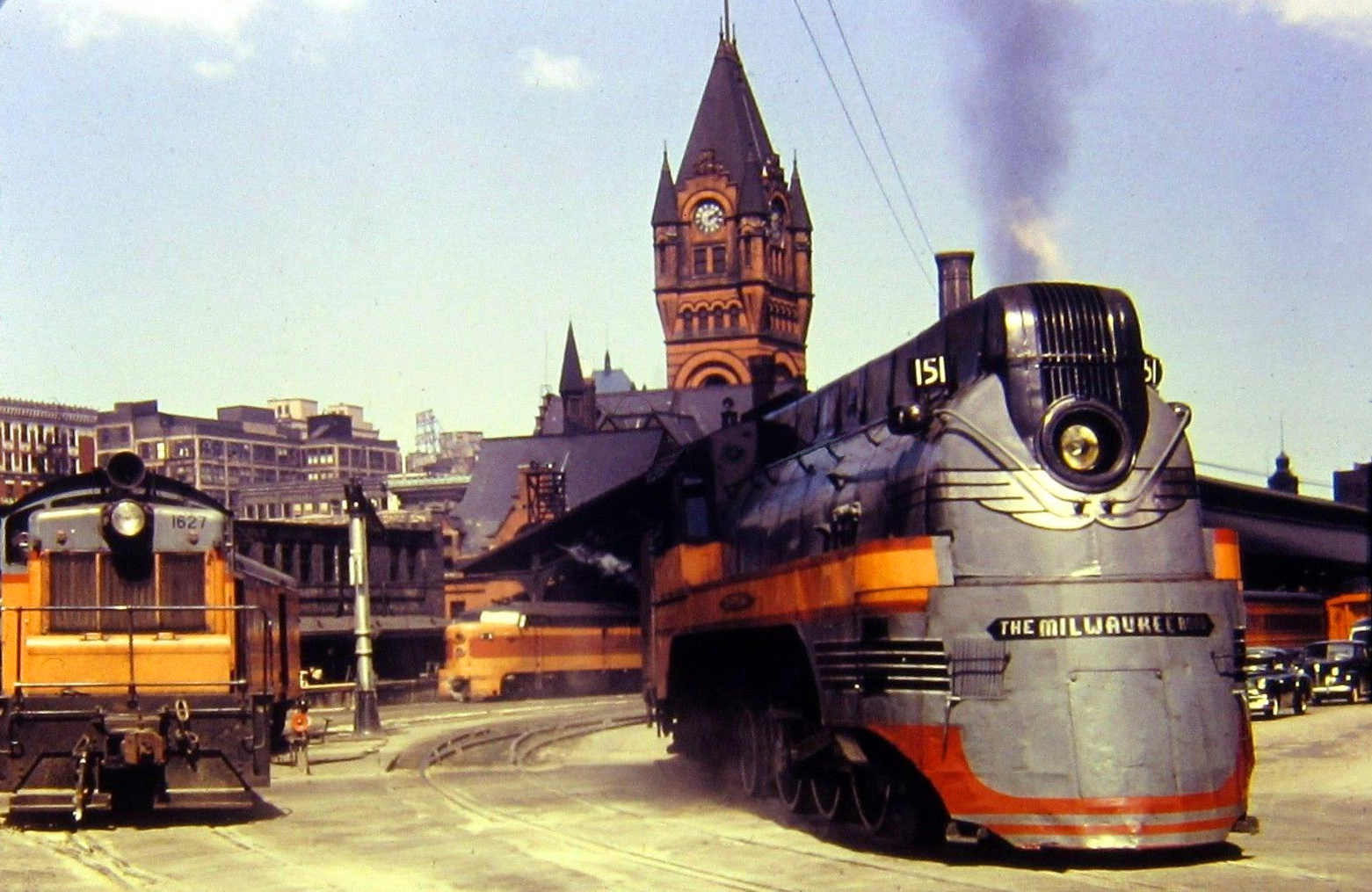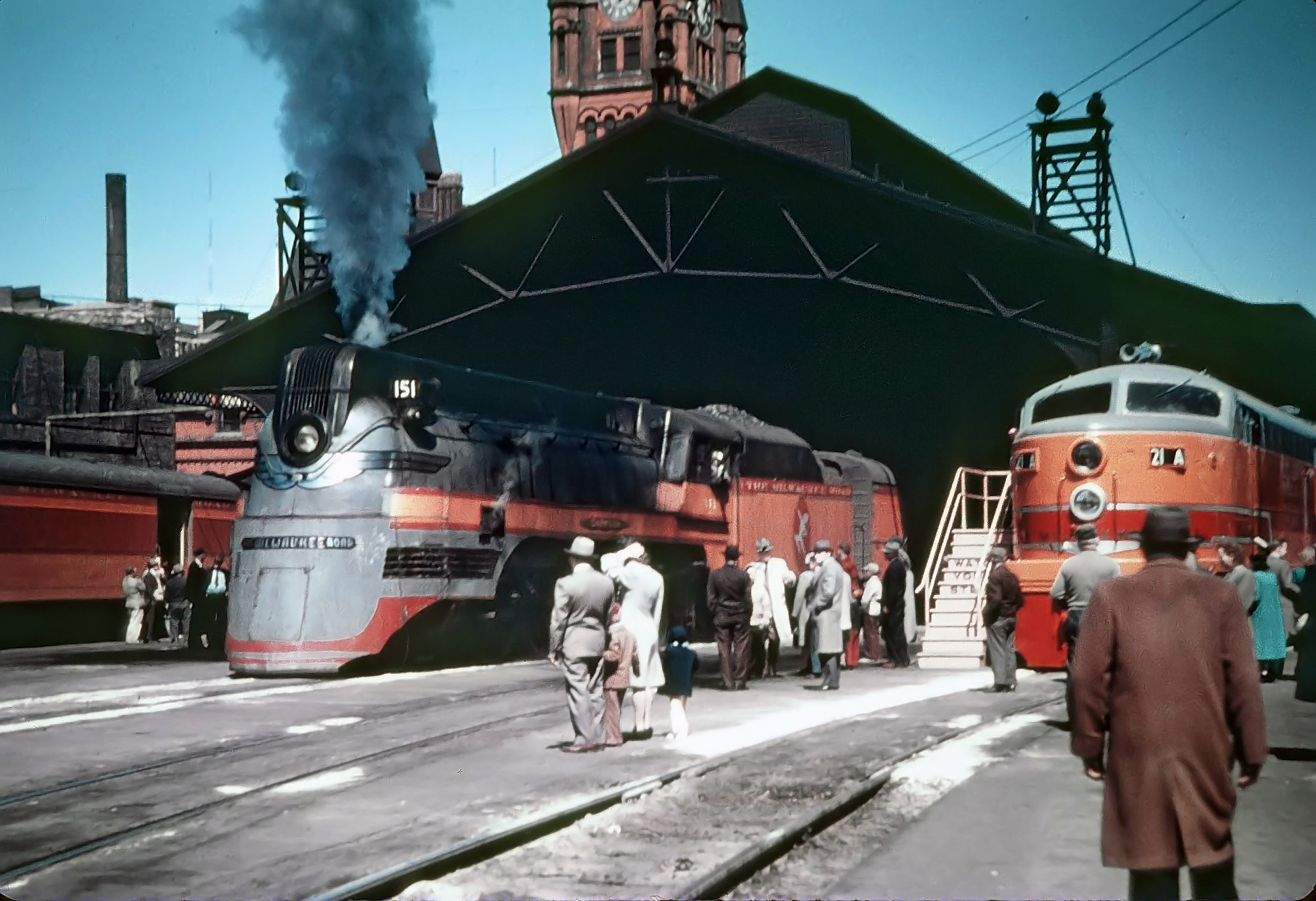Everett Street Depot (Milwaukee): 1886-1966
Last revised: September 6, 2024
By: Adam Burns
The Everett Street Depot, an architectural jewel and pivotal railway hub, has an undeniable place in Milwaukee’s history. It's a testament to the city's rich railroad culture, offering reflection of a past era.
The station was the creative work of renowned architect Edward Townsend Mix. Known for many famed constructs, Mix's folly into the realm of railway station design resulted in this mesmerizing structure, one highly spoken of by architectural historians and rail enthusiasts alike.
Everett Street officially opened its doors to the public on August 18, 1886, symbolizing another step forward in Milwaukee's progression.
Photos
 A busy scene at Milwaukee Road's Everett Street Station in Milwaukee, Wisconsin, circa 1950. The building's signature clock tower is clearly visible in the background. In the foreground is 4-6-2 #151, shrouded in 1941 by the Milwaukee Shops for the "Chippewa." Officially retired on June 4, 1954.
A busy scene at Milwaukee Road's Everett Street Station in Milwaukee, Wisconsin, circa 1950. The building's signature clock tower is clearly visible in the background. In the foreground is 4-6-2 #151, shrouded in 1941 by the Milwaukee Shops for the "Chippewa." Officially retired on June 4, 1954.Construction
Constructed with a staggering cost of $200,000, according to 19th-century estimates, the station was a significant investment, reflecting the commitment and faith Milwaukee displayed in advancing its railway infrastructure.
Architecture
The station was intricately designed in the lively Richardsonian Romanesque style of architecture. Emphasizing heavy stonework, it exuded durability and grandeur, synonymous with the ambitious rail transport spirit of the time.
The sheer majesty of this robust structure was crafted from Lake Superior Sandstone, specifically quarried for the station's construction. The sandy, light-colored stone bestowed an exclusive character to this beloved edifice.
Situated in downtown Milwaukee, just across the Menomonee River, the station straddled the intersection of Everett and Clybourn Streets; this central location made it a bustling hub nestled in the city's thriving heart.
The Everett Street Depot was equipped with an impressive four tracks beneath a long train shed as well as with additional staging tracks to each side of the structure.
At its height, the station served a breathtaking number of approximately 2,500 passengers daily, maneuvering around 50 trains. Such numbers showcased the sheer scale of operations and the importance of station within the city's rail framework.
Milwaukee Road
Among the myriad of trains it served, the station was especially famous for hosting Milwaukee Road's noted Hiawatha passenger trains. These distinguished trains were famous for their rapid service, a tangible manifestation of Milwaukee's dynamic spirit.
All of the railroad's long distance Hiawathas served the facility, except for the Midwest Hiawatha which served the Iowa Division (Chicago - Omaha/Council Bluffs). During the great age of streamliners during the late 1930s through the early World War II era one could commonly witness the Milwaukee's legendary 4-4-2s Class As and 4-6-4 Class F-7s arriving and departing from the facility.
The Milwaukee Road was synonymous with the Hiawatha service, and with Everett Street serving many of these swift passenger trains, the station's significance scaled even higher.
Interestingly, the moniker 'Hiawatha' was derived from an epic poem by Henry Wadsworth Longfellow. The Milwaukee Road adopted this name, aiming to symbolize the comfort, speed, and efficiency of their service, aspects fittingly aligned with the station's values.
 Another classic scene at the Everett Street Depot. Closest to the photographer is streamlined 4-6-2 #151, lead power for the "Chippewa," while a brand new "Erie-Built" is one display at right in the fall of 1947. A.C. Kalmbach photo, Rick Burn collection.
Another classic scene at the Everett Street Depot. Closest to the photographer is streamlined 4-6-2 #151, lead power for the "Chippewa," while a brand new "Erie-Built" is one display at right in the fall of 1947. A.C. Kalmbach photo, Rick Burn collection.Closure
The first changes to the station occurred during the 1950s when its majestic, 140-foot tall clock tower was lowered with the actual clock placed just above the roofline.
The structure officially ended service to the public on August 1, 1965, marking the end of an era in which the Everett Street Depot stood as a beacon for Milwaukee's industrial vigor and ambition.
Following the end of service to the facility the Milwaukee Road moved operations over to its new Milwaukee Union Station, which opened on August 3, 1965. The following year, the Chicago & North Western closed its beautiful Lake Front Depot and also moved its trains to the facility.
Unfortunately, the new Union Station carried none of its predecessor's charm or beautiful architecture. In 2007 it was renamed as the Milwaukee Intermodal Station and remains in use today.
Demolition
Unfortunately, the physical existence of Everett Street was marked by demolition on June 15, 1966, a little under a year after its closure. This poignant end, however, did not erase the station's historical relevance and contribution.
Despite its eventual demolition, the depot left a lasting monumental legacy. Its contribution during its 79-year tenure to Milwaukee's growth and the people it served remains unmistakable.
Several reasons led to the closure of this pivotal station. This was the result of a series of changes in the socio-economic and transportation landscape of Milwaukee. Passenger numbers dwindled as a direct result of the increase in highway construction and a surging preference for air travel.
Moreover, the cost to manage and maintain such a grand structure that was slowly losing its patronage also contributed to its closure. As business viability eroded, the decision to close Everett Street was accepted as an inevitable consequence of broader industry transformation.
It's worth noting that despite the station's closure and eventual demolition, the site was eventually repurposed and given a new lease on life. Although, that lease required many years; the site remained vacant until 1986 when Wisconsin Electric Power (today known as We Energies) built an office annex on the site.
In addition, Interstate 794 now occupies the location where the train shed and tracks once stood; a somewhat fitting statement in America's abandonment of trains for highways.
A few reminders of the facility remain today, however. One of the station's clock faces has been preserved and is currently owned by the Betty Brinn Children's Museum building, located at 929 East Wisconsin Avenue in Milwaukee. In addition, Zeidler Union Square is still maintained, a handsome small park that was essentially the station's front yard.
Legacy
In conclusion, Everett Street Depot, whether hosting the swift Hiawatha service or standing as a testament to the grandeur of the Milwaukee Road's contributions, was never just a station. It was a beacon symbolizing Milwaukee’s spirit.
Recalling the grandeur of station, its sandstone halls bustling with passengers, the last minute rush to board the Hiawatha, is to remember a time when Milwaukee Road was more than a railway corporation. It was a socio-economic vehicle that transported Milwaukee onto the broader stage of industry and progress.
The voices and footfalls of the thousands who passed through the station have faded. However, their echoes live on, etched into the narrative of a city molded and shaped by the iron ore and toil of those who believed in the promise of a better future.
The reality of the city’s transformation may have pushed structures like the Everett Street out of the physical landscape. Yet, their mere existence is a testament to a past vibrantly alive in the city's memories and its history.
Examining the trajectory of the facility reveals a parallel pattern of growth, flourish, decline, and eventual disappearance. A reaffirmation that Milwaukee has always been an ever- evolving entity, transforming with the times.
Ultimately, the story of station is not limited to dates, stone, and design. It is a sociological exploration of Milwaukee through the frame of a railway station. It is a story of progress, ambition, changing times, and the unyielding spirit of a city that thrives on adaptation.
The Everett Street Depot did not merely house the tracks of the Milwaukee Road or the swift Hiawatha service. It was home to the hopes and dreams of a city on the move. It symbolized a journey - some would say a chronicle - of Milwaukee's pursuit of development.
While the station may have vanished from sight, it lingers on, an indomitable ghost in Milwaukee's urban fabric.
A poignant symbol of a city’s unfaltering stride to remain relevant, even as time and technology transform the scenery. After all, the echo of the last Hiawatha departing from its platform continues to resonate in the story of Milwaukee's railroading past, present, and future.
Recent Articles
-
Massachusetts - Wine Tasting - Train Rides
Dec 26, 25 03:37 PM
This article dives into some of the alluring aspects of wine by rail in Massachusetts, currently offered by the Cape Cod Central Railroad. -
Maryland - Wine Tasting - Train Rides
Dec 26, 25 03:34 PM
This article delves into the enchanting world of wine tasting train experiences in Maryland, providing a detailed exploration of their offerings, history, and allure. -
Florida Thomas The Train Rides
Dec 26, 25 03:32 PM
Each year, Day Out With Thomas™ turns the Florida Railroad Museum in Parrish into a full-on family festival built around one big moment: stepping aboard a real train pulled by a life-size Thomas the T…



